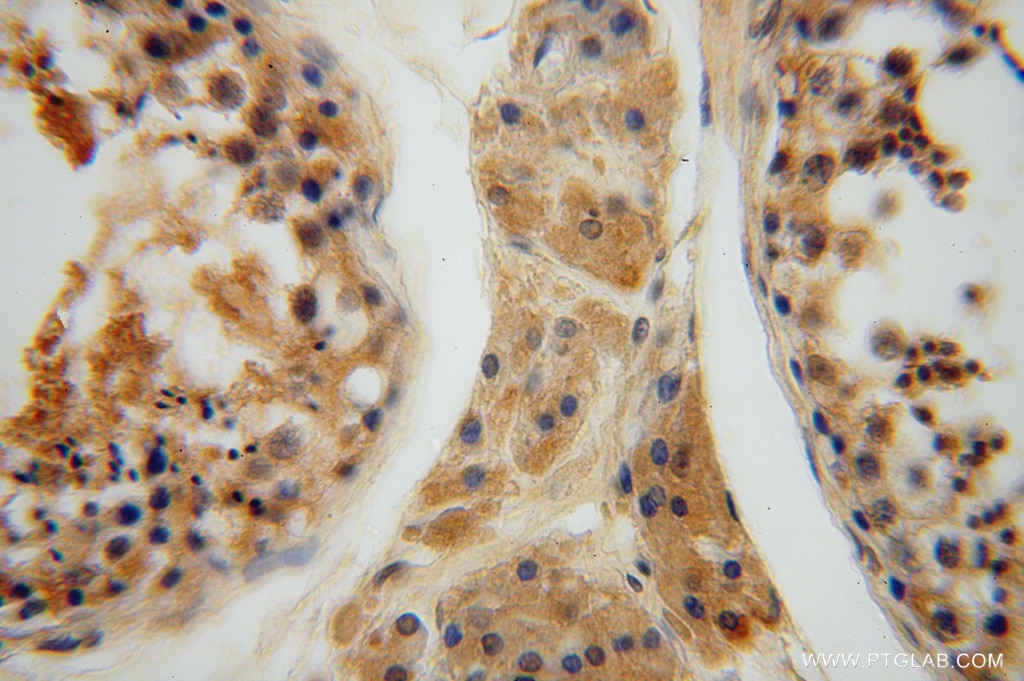- Phare
- Validé par KD/KO
Anticorps Polyclonal de lapin anti-HIP14; ZDHHC17
HIP14; ZDHHC17 Polyclonal Antibody for WB, IHC, ELISA
Hôte / Isotype
Lapin / IgG
Réactivité testée
Humain, rat, souris
Applications
WB, IF, IHC, ELISA
Conjugaison
Non conjugué
N° de cat : 15465-1-AP
Synonymes
Galerie de données de validation
Applications testées
| Résultats positifs en WB | cellules Raji, tissu rénal humain |
| Résultats positifs en IHC | tissu testiculaire humain il est suggéré de démasquer l'antigène avec un tampon de TE buffer pH 9.0; (*) À défaut, 'le démasquage de l'antigène peut être 'effectué avec un tampon citrate pH 6,0. |
Dilution recommandée
| Application | Dilution |
|---|---|
| Western Blot (WB) | WB : 1:500-1:1000 |
| Immunohistochimie (IHC) | IHC : 1:20-1:200 |
| It is recommended that this reagent should be titrated in each testing system to obtain optimal results. | |
| Sample-dependent, check data in validation data gallery | |
Applications publiées
| KD/KO | See 1 publications below |
| WB | See 3 publications below |
| IHC | See 1 publications below |
| IF | See 1 publications below |
Informations sur le produit
15465-1-AP cible HIP14; ZDHHC17 dans les applications de WB, IF, IHC, ELISA et montre une réactivité avec des échantillons Humain, rat, souris
| Réactivité | Humain, rat, souris |
| Réactivité citée | Humain, souris |
| Hôte / Isotype | Lapin / IgG |
| Clonalité | Polyclonal |
| Type | Anticorps |
| Immunogène | HIP14; ZDHHC17 Protéine recombinante Ag7763 |
| Nom complet | zinc finger, DHHC-type containing 17 |
| Masse moléculaire calculée | 73 kDa |
| Poids moléculaire observé | 70 kDa |
| Numéro d’acquisition GenBank | BC050324 |
| Symbole du gène | ZDHHC17 |
| Identification du gène (NCBI) | 23390 |
| Conjugaison | Non conjugué |
| Forme | Liquide |
| Méthode de purification | Purification par affinité contre l'antigène |
| Tampon de stockage | PBS avec azoture de sodium à 0,02 % et glycérol à 50 % pH 7,3 |
| Conditions de stockage | Stocker à -20°C. Stable pendant un an après l'expédition. L'aliquotage n'est pas nécessaire pour le stockage à -20oC Les 20ul contiennent 0,1% de BSA. |
Informations générales
Post-translational modification by the lipid palmitate is crucial for the correct targeting and function of many proteins. Polyglutamine expansions of huntingtin protein are responsible for the Huntington neurological disorder. ZDHHC17 gene encodes palmitoyl transferase huntingtin interacting protein (HIP14) which regulates palmitoylation and distribution of hungtingtin. The latter is implicated in the formation of inclusion bodies and enhanced neuronal toxicity. HIP14 was also shown to control neurotransmitter release.
Protocole
| Product Specific Protocols | |
|---|---|
| WB protocol for HIP14; ZDHHC17 antibody 15465-1-AP | Download protocol |
| IHC protocol for HIP14; ZDHHC17 antibody 15465-1-AP | Download protocol |
| Standard Protocols | |
|---|---|
| Click here to view our Standard Protocols |
Publications
| Species | Application | Title |
|---|---|---|
mBio Identification of ZDHHC17 as a Potential Drug Target for Swine Acute Diarrhea Syndrome Coronavirus Infection
| ||
J Cell Sci Activity-dependent post-translational regulation of palmitoylating and depalmitoylating enzymes in the hippocampus | ||
Mol Cell Endocrinol ZDHHC17 participates in the pathogenesis of polycystic ovary syndrome by affecting androgen conversion to estrogen in granulosa cells |





